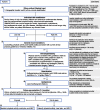Diabetes-specific nutrition algorithm: a transcultural program to optimize diabetes and prediabetes care
- PMID: 22322477
- PMCID: PMC3303078
- DOI: 10.1007/s11892-012-0253-z
Diabetes-specific nutrition algorithm: a transcultural program to optimize diabetes and prediabetes care
Abstract
Type 2 diabetes (T2D) and prediabetes have a major global impact through high disease prevalence, significant downstream pathophysiologic effects, and enormous financial liabilities. To mitigate this disease burden, interventions of proven effectiveness must be used. Evidence shows that nutrition therapy improves glycemic control and reduces the risks of diabetes and its complications. Accordingly, diabetes-specific nutrition therapy should be incorporated into comprehensive patient management programs. Evidence-based recommendations for healthy lifestyles that include healthy eating can be found in clinical practice guidelines (CPGs) from professional medical organizations. To enable broad implementation of these guidelines, recommendations must be reconstructed to account for cultural differences in lifestyle, food availability, and genetic factors. To begin, published CPGs and relevant medical literature were reviewed and evidence ratings applied according to established protocols for guidelines. From this information, an algorithm for the nutritional management of people with T2D and prediabetes was created. Subsequently, algorithm nodes were populated with transcultural attributes to guide decisions. The resultant transcultural diabetes-specific nutrition algorithm (tDNA) was simplified and optimized for global implementation and validation according to current standards for CPG development and cultural adaptation. Thus, the tDNA is a tool to facilitate the delivery of nutrition therapy to patients with T2D and prediabetes in a variety of cultures and geographic locations. It is anticipated that this novel approach can reduce the burden of diabetes, improve quality of life, and save lives. The specific Southeast Asian and Asian Indian tDNA versions can be found in companion articles in this issue of Current Diabetes Reports.
Figures

References
-
- International Diabetes Federation . IDF diabetes atlas. 4. Brussels: International Diabetes Federation; 2009. - PubMed
-
- The effect of intensive treatment of diabetes on the development and progression of long-term complications in insulin-dependent diabetes mellitus. The Diabetes Control and Complications Trial Research Group. N Engl J Med. 1993;329:977–86. - PubMed
-
- Intensive blood-glucose control with sulphonylureas or insulin compared with conventional treatment and risk of complications in patients with type 2 diabetes (UKPDS 33). UK Prospective Diabetes Study (UKPDS) Group. Lancet. 1998;352:837–53. - PubMed
Publication types
MeSH terms
Substances
LinkOut - more resources
Full Text Sources
Other Literature Sources
Medical

